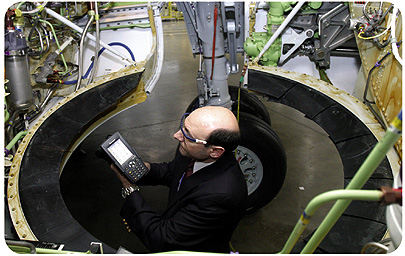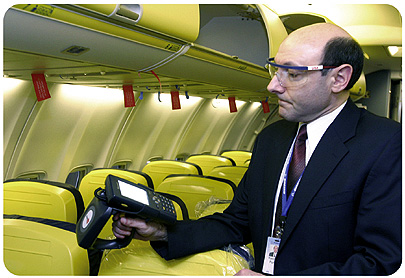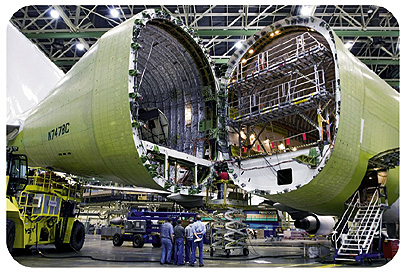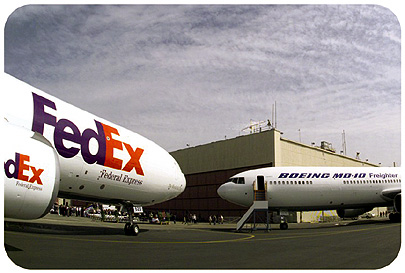Dec 01, 2006En route from San Francisco International Airport to Hong Kong International Airport, a Boeing 787 experiences mechanical difficulties. A component inside the plane begins to overheat. The flight crew may be unaware of the problem, but a maintenance crew at the Hong Kong airport jumps into action. The failed component doesn't present any danger to the flight or passengers—parts redundancy is built into all Boeing planes, so one of two other identical parts takes over. But the component must be replaced before the aircraft takes off again. When the plane lands safely in Hong Kong, the maintenance crew is waiting with the new part.
The maintenance crew was alerted to the problem because an active tag attached to the part was read by the plane's onboard RFID system. A sensor embedded in the tag captured the temperature reading and included it in the tag's data transmission. The high reading triggered an alert that was transmitted to the ground crew via satellite. Once the crew was aware of the problem, it used an RFID asset-tracking system to quickly locate the part in Boeing's inventory facility.

This is a fictional scenario, but in four years or so, it could be standard operating procedure, says Ken Porad, a Boeing associate technical fellow and the program manager for Boeing Commercial Airplanes' automated identification program. In August, Boeing, in partnership with FedEx, ran a series of tests to see what effect, if any, active RFID tags—some with integrated sensors—attached to various parts inside a Boeing MD-10 cargo plane would have on the plane's instrumentation. The test results showed just what Porad was hoping for: nothing.
The tags' presence did not create any electromagnetic interference with the plane's navigation or communications systems. The heat, cold, dirt, shock and vibration to which the tags were exposed during a 90-day in-service test did not negatively impact their performance. And the data encoded to the tags was still readable at the end of each test.
Boeing plans to submit its findings by year's end to the Federal Aviation Administration, in hopes that the regulatory agency will determine that the RF transmissions from active tags aboard in-service planes do not pose any mechanical or communications concerns regarding the safe operation of civil aircraft. It's possible that the agency won't rule on whether active RFID tags can be used on planes until the end of 2007.
It's not the first time that Porad has had to wait for FAA rulings to move ahead on Boeing's RFID initiatives. In 2003 and 2004, the aircraft manufacturer conducted two proof-of-technology tests—the first using passive high-frequency tags, the latter using passive ultrahigh-frequency tags. In each case, the tests raised no safety issues, and the FAA issued a policy that allows the use of passive tags on planes. That policy opened the door for Boeing's groundbreaking project: applying passive tags to aircraft parts that will be used in its upcoming 787 Dreamliner family of commercial aircraft, to improve parts tracking and maintenance. The FAA ruling on passive tags also provided clearance for airlines to tag passenger baggage and for companies to tag cargo containers.
But to turn our fictional scenario into reality, Boeing needs permission to use active tags, which have enough onboard processing power to support sensors. (Passive tags have no power of their own; they exploit power from an interrogator.) In addition to ushering in sweeping improvements to parts' life-cycle maintenance, the use of active tags with sensors would provide insights into the conditions to which parts are exposed during a plane's journey—information Boeing could use to improve aircraft design. Shipping companies and carriers, such as FedEx, are also keeping an eye out for the ruling, because if active tags and sensors could be added to cargo containers, it would increase visibility into the conditions of perishable goods in transit.
Since 2004, Boeing has been using RFID to track parts shipped to its receiving facilities in Philadelphia and St. Louis. Suppliers apply passive Electronic Product Code tags to cases and pallets of some parts and send advance shipment notices (ASNs) that include the EPC encoded to the tags. When Boeing receives the shipments, it reads the tags and compares the EPCs to those listed on the ASNs, saving labor and increasing the accuracy of its parts-receiving process.
In 2004, when Boeing announced its upcoming line of 787 passenger planes—dubbed the Dreamliner—Porad realized the company could take its parts tracking to another level: using RFID to track a part's maintenance history throughout its life cycle. Federal aviation regulations require that each part's history be tracked individually. Today, aircraft manufacturers, parts suppliers and carriers do this through a standardized bar-code system. Porad believed that migrating to an RFID-based system would make identifying the parts more accurate and accessing their maintenance records simpler.
"I proposed we make it the first plane in aviation history to use RFID to identify parts," says Porad. "Management asked if the technology was ready, and I persuaded them it was." But first, he had to clear it with the FAA.
"When I said to the regulatory agency, 'We have no national policy on RFID for parts tracking on an airplane,' they said, 'Well, you can develop one with us, then.' So I became the poster child for getting this whole [parts tracking using passive RFID] thing going," says Porad.
In October 2003, Boeing conducted a 90-day in-service evaluation of HF passive tags attached to 40 parts on a Boeing MD-10 cargo carrier owned and operated by FedEx, one of its airline customers and a partner in the project. In 2004, Boeing and FedEx repeated the test, this time using UHF passive tags, because they offer a longer read range and were then headed toward an international standard, which has since been adopted by EPCglobal and the International Standards Organization.
The tests of both passive tags showed that RFID did not interfere with equipment on the airplane necessary for continued safe flight and landing. Based on this, the FAA issued a policy in May 2005 stating that passive RFID tags could be attached to aircraft parts, as well as to cargo containers and baggage tags.
The tests also showed that the tags could withstand the rigors—heat, cold, dirt, shock and vibration—to which aircraft parts are exposed during flight. The data encoded to the tags was still readable at the end of each test. These results were the proof of concept to Boeing.
With the green light to proceed, Porad announced its Dreamliner RFID-tagging initiative in October 2005. Boeing identified 700 part types—all told, 2,000 parts—that would be useful in the 787, and said it wanted all of these parts tagged by the manufacturers before they were shipped to Boeing. The manufacturers are being required to use passive UHF Gen 2 tags with 64 kilobits of memory, which will allow airlines to encode each part's maintenance information directly to the tag.
Manufacturers will permanently attach the tag to a part and encode an identifying part number, a serial number (because the part number changes as modifications are made to the part during its life cycle), and a manufacturer code to the tag. This data will also be encoded to a bar code and printed onto a nameplate that is attached to the part, which is how parts are currently identified. (This data is linked to an updatable database that aviation industry supply-chain partners can access.)
Also significant is the time airline mechanics will save accessing a part's maintenance history and locating spare parts. Mechanics will be able to use a handheld computer to read the tag on a part that is brought in for service, which will give immediate access to its repair history, instead of looking up the information in a maintenance log or an Internet-based parts database. This will be possible only because Boeing is working with Intelleflex to develop an aviation-grade high-memory tag.

"A lot of people didn't understand the need for a significant amount of memory on the tag," says Porad. "But sometimes the mechanic doesn't have access to the Internet. Or they want to loan, borrow or exchange parts, and they need to know immediately if that part is interchangeable on their airplane. That info needs to be at the mechanic's fingertips."
Boeing plans to install RFID interrogators in its parts warehouses. Today, airline mechanics spend more than half of their time searching for specific parts. Porad estimates that using RFID to track parts and hold their maintenance files could significantly reduce the cycle time to solve in-service problems.
Eventually, essential gear such as life preservers and emergency equipment—which airline crew are legally required to count before each flight—will also be tagged. Instead of walking down the airplane aisle and eyeballing each equipment item and lifting each seat, they could use a handheld interrogator. Porad predicts that RFID could reduce the time crews spend on this task between flights from a half-hour to five to seven minutes, which could help keep flights on schedule.
RFID also promises to deter the introduction of unapproved parts into the aviation supply chain, because RFID-tagged parts could be easily verified and authenticated. This should benefit Boeing's suppliers, which lose considerable income through the black and gray markets for airline parts. And suppliers could benefit from more accurate record keeping, because it could reduce the costs associated with warranty claim processing.
If and when the FAA clears the use of active tags on planes, Boeing won't prescribe them for all parts or equipment. Active tags are more expensive than passive tags, and there would be no additional benefit to attaching them to, say, life preservers and oxygen masks. Boeing will use active tags when it needs a read range of hundreds of feet (passive tags cap out at 30 or so) and when it wants to add sensors to the tags.
Boeing's airline customers—cargo shippers such as FedEx and passenger carriers such as United—need to access parts-maintenance information to help determine when to schedule service for a plane, or overhaul or replace a part. The higher memory capacity and extended range of active tags could allow ground crews to determine the life cycle of some tagged parts just by opening large hatches to the plane, rather than entering it, or in some cases without opening face plates or access bins that house the parts, which will save time and streamline record keeping.

As part of the active tag tests—in which 40 active RFID tags were attached to various parts inside a FedEx-owned Boeing MD-10 cargo plane—Boeing tested the extended read range. When it opened one of the main aircraft hatches, the ground crew was able to fix a read on all 40 tags without entering the plane.
If sensors were added to active tags used on an aircraft, it would transform the tags from tools for identification and record keeping to sensing agents distributed throughout an aircraft. They would form sophisticated wireless sensor networks that could provide visibility into the conditions to which parts are exposed. In the short term, the information could be used as an advance warning for maintenance crews that repairs are needed. In the long term, the aggregation of environmental data collected from parts or assemblies that suffer chronic failures could prompt Boeing designers to re-design aircraft components, and parts manufacturers to change the materials or configuration of their parts.
A lot is riding on the FAA's decision, but based on the results of the active tag tests, Porad and James Ford, manager of engineering support for FedEx, feel confident that the FAA will approve their use. Also, prior to the commencement of the active-tag tests, FAA officials said they did not expect the power level of an active tag—only one one-thousandth of a watt, less power than a cell phone—to present any interference or safety concerns.
The FAA rulings on passive and active tags could affect global standards. The European Aviation Safety Agency, which oversees civil aviation safety in Europe, has released a policy on the use of passive tags that is nearly identical to the FAA's policy. The FAA and EASA hold sway over most of the other national and regional civil aviation agencies around the world, says Jon Andresen, president of aviation IT consultancy Technology Solutions, so their RFID policies will likely become the global standard.
RFID has been keeping Porad and other project leaders at Boeing busy. The company was an early adopter of the technology, starting in the late 1990s, when it began using RFID in closed-loop manufacturing automation and asset management applications in its facilities.
"The hardest part of my job is the continuing education and persuasion," says Porad. "I have presented our vision to literally many thousands in the past few years. Progress is slow but steady, and patience is required. We have had early successes and are confident a successful solution will be deployed. My greatest feeling of accomplishment comes from the in-service evaluations with FedEx, where we were the first to outfit airplane parts with a significant number of RFID transponders. This was pioneering."

But Porad can't rest on his laurels as he awaits the FAA decision. Boeing must collaborate with its suppliers and customers—and even its competitors—to make the Dreamliner passive-tag rollout, and possible subsequent rollouts with active tags, work.
Unlike Wal-Mart and the U.S. Department of Defense, Boeing is not mandating that the designated Dreamliner suppliers apply RFID tags to shipments of goods. Porad uses the words "tagging requirement" and is demure when asked about whether suppliers that won't tag their parts will suffer negative ramifications. Rather, he characterizes the process of tagging parts as a close collaboration between Boeing and its Dreamliner suppliers—though the suppliers will carry the cost of the Dreamliner tags, some of which may cost as much as $20 each.
"Boeing is playing a critical role in implementing RFID in the aviation industry," says Andresen, who is working with the Air Transport Association, a U.S. trade organization that is setting standards for RFID use in aviation. "I applaud Boeing's patience and its style in saying, 'Look, we want to work with you, but we also want to be clear that we want to do this.' Boeing wants its suppliers' agreement and support, but it's not threatening. Boeing does not want to shove this down a supplier's throat."
Boeing first learned that collaboration is key to deploying supply-chain technologies a dozen years ago, when it joined with Airbus to bring the industry's old-school, manual approach to parts and order tracking into the electronic age. Rather than mandating the use of bar codes, Andresen says Boeing and Airbus showed both parts suppliers and airlines how the use of bar codes would improve business processes and lower costs.
The two plane makers joined forces again in 2005, co-presenting a series of aviation industry forums to educate suppliers and airlines on how RFID can be used to further these efficiencies. Porad hopes Airbus will partner with Boeing on these forums again in 2007, so that they can speak with one voice about standardizing RFID within aviation. "Boeing and Airbus share 70 percent common suppliers, and to provide inconsistent direction to common suppliers would be ugly and foolish—even worse for a customer that has a mixed Boeing-Airbus fleet," says Porad. "If we have a different approach—different protocol, frequency—there would be an upheaval in the industry. We can't do that."
Porad says the type of cooperation that Boeing and Airbus have done is being followed by other industiries, including automotive and pharmaceutical, in setting standards for EPC applications. "I think we were the first major competitors to set aside our differences for the betterment of the industry, and others are following our lead," he says. "We really have done some great things. We set the stage. EPCglobal mentions us as a model; it tells its members that if Boeing and Airbus can work together, then other companies can do it as well."
In the end, Boeing is most concerned with improving its business processes. The company believes that RFID is a means to that end, but what's really driving Boeing's push for RFID is the increased data, through identification and sensing, that it provides. "Five years ago, we were talking about bar codes," says Andresen. "A decade from now, we'll have a new technology. It's not about the technology, it's about the data."

